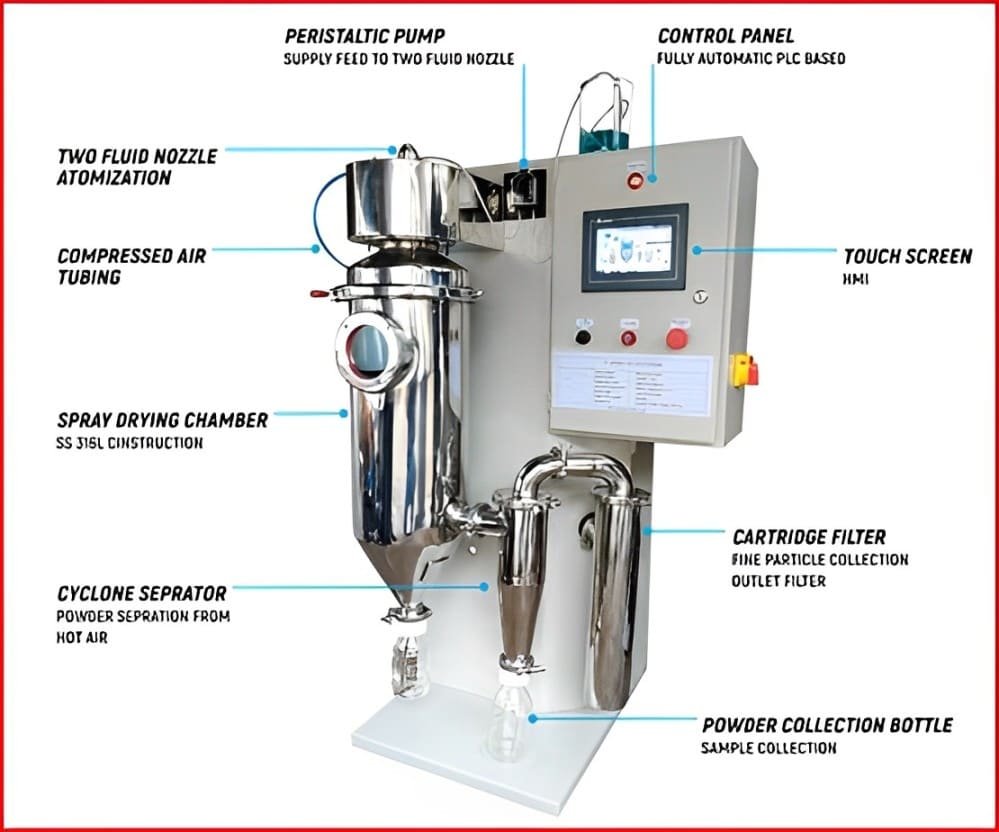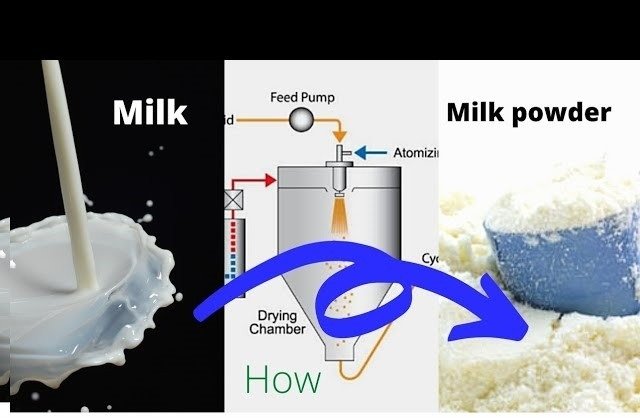
Spray drying plays a crucial role in the dairy industry, especially for producing milk powder. This method transforms liquid milk into a fine powder, extending its shelf life and making it easier to transport and store. In this comprehensive guide, we will explore the spray drying process of milk, the machines involved, and the benefits of using spray dryers for milk powder production. Understanding this process helps dairy professionals enhance their operations and ensure high-quality milk powder products.
What is Spray Drying?
Spray drying is a dehydration technique that converts liquid substances into dry powders. The process involves atomizing the liquid into small droplets and then rapidly drying them with hot air. Various industries, including food, pharmaceuticals, and chemicals, widely use this method. It is particularly significant in the dairy industry for producing milk powder.
The Spray Drying Process of Milk
1. Pre-concentration: In the first step of spray drying milk, you need to pre-concentrate the milk. Raw milk contains about 87% water, which you need to reduce before spray drying. Typically, you achieve this through evaporation, heating the milk under reduced pressure to remove a significant portion of the water content. The pre-concentrated milk, which now contains around 45-50% solids, is ready for the spray drying process.
2. Atomization: Atomization converts the pre-concentrated milk into fine droplets. A spray dryer machine for milk powder, which includes an atomizer, performs this task. You can choose between two main types of atomizers used in milk spray dryer machines: rotary atomizers and nozzle atomizers. Rotary atomizers use a high-speed rotating disk to disperse the milk, while nozzle atomizers force the milk through a small orifice to create a spray of fine droplets.
3. Drying: After atomizing the milk, the fine droplets enter a drying chamber where they contact hot air. The temperature of the hot air ranges between 150-300°C, depending on the desired properties of the final milk powder. As the droplets encounter the hot air, the moisture rapidly evaporates, leaving behind dry milk powder particles. Carefully controlling the drying process prevents overheating, which can affect the quality and nutritional value of the milk powder.
4. Powder Collection: You collect the milk powder particles from the drying chamber after drying. Usually, a cyclone separator separates the fine powder from the air. The collected powder then passes through a series of sieves to ensure uniform particle size and remove any oversized particles. The final product is a fine, free-flowing milk powder that you can easily package and store.


Types of Spray Dryer Machines for Milk Powder
Several types of spray dryer machines produce milk powder, each with unique features and advantages. Here are some of the most common types:
1. Rotary Atomizer Spray Dryers: Rotary atomizer spray dryers use a high-speed rotating disk to disperse the pre-concentrated milk into fine droplets. These machines produce uniform particle sizes and high-quality milk powder. They are ideal for large-scale production and can handle a wide range of milk concentrations.
2. Nozzle Atomizer Spray Dryers: Nozzle atomizer spray dryers force the pre-concentrated milk through a small orifice to create a spray of fine droplets. These machines produce milk powder with specific particle sizes and often serve smaller-scale operations. They offer precise control over the droplet size and drying parameters, making them ideal for producing customized milk powders.
3. Fluidized Bed Spray Dryers: Fluidized bed spray dryers combine spray drying with fluidized bed technology to produce milk powder with excellent flow properties and uniform particle size distribution. These machines are particularly effective for drying heat-sensitive products, as you can precisely control the drying temperature. They commonly serve the dairy industry by producing high-quality milk powders with enhanced solubility and stability.
Benefits of Using Spray Dryers for Milk Powder Production
Using spray dryers for milk powder production offers several advantages over other drying methods. Here are some of the key benefits:
1. Extended Shelf Life: Spray drying significantly reduces the moisture content of milk, extending its shelf life and making it less prone to spoilage. This is particularly important for ensuring the availability of milk products in regions with limited refrigeration facilities.
2. Enhanced Nutritional Value: Spray drying preserves the nutritional value of milk by minimizing heat exposure during the drying process. This ensures that essential vitamins, minerals, and proteins remain in the final milk powder product.
3. Improved Solubility: Milk powder produced through spray drying has excellent solubility, making it easy to reconstitute into liquid milk. This is especially important for consumers who rely on milk powder for daily consumption.
4. Cost-Effective: Spray drying is a cost-effective method for producing milk powder, as it allows for large-scale production and efficient use of energy. The process can be easily automated, reducing labor costs and increasing productivity.
5. Versatility: Spray dryers can produce a wide range of milk powder products with different properties and applications. This includes whole milk powder, skim milk powder, and specialized formulations for infant nutrition, sports nutrition, and other specific dietary needs.
Key Considerations for Choosing a Milk Spray Dryer Machine
When selecting a milk spray dryer machine for your dairy operation, consider the following factors to ensure optimal performance and product quality:
1. Capacity: Choose a spray dryer machine with a capacity that matches your production requirements. Consider the volume of milk you need to process and select a machine that can handle the desired throughput.
2. Type of Atomizer: Select the appropriate atomizer type based on your production needs. Rotary atomizers suit large-scale operations, while nozzle atomizers offer precise control for smaller-scale production.
3. Temperature Control: Ensure that the spray dryer machine provides accurate temperature control to prevent overheating and preserve the nutritional value of the milk powder. Look for machines with advanced temperature monitoring and control systems.
4. Energy Efficiency: Consider the energy efficiency of the spray dryer machine, as this significantly impacts your operating costs. Look for machines that offer efficient energy use and minimize waste.
5. Maintenance and Cleaning: Choose a spray dryer machine that is easy to maintain and clean. Regular maintenance and cleaning are essential for ensuring the longevity of the machine and the quality of the milk powder.

Advances in Spray Drying Technology for Milk Powder
The dairy industry has seen significant advancements in spray drying technology, leading to improved efficiency, product quality, and sustainability. Here are some of the latest innovations in spray drying technology for milk powder production:
1. Advanced Atomization Techniques: New atomization techniques, such as ultrasonic atomization, offer improved control over droplet size and distribution. This results in more uniform particle sizes and enhanced product quality.
2. Energy Recovery Systems: Energy recovery systems are being integrated into spray dryer machines to capture and reuse heat energy from the drying process. This reduces energy consumption and lowers operating costs.
3. Real-Time Monitoring and Control: Advanced monitoring and control systems provide real-time data on the drying process, allowing for precise adjustments to ensure optimal product quality. These systems can detect and correct deviations in temperature, airflow, and other parameters.
4. Sustainable Drying Solutions: Sustainable spray drying solutions focus on reducing the environmental impact of the drying process. This includes using renewable energy sources, waste heat recovery, and efficient water use.
5. Customized Formulations: Innovations in spray drying technology enable the production of customized milk powder formulations with specific nutritional profiles and functional properties. This is particularly important for producing specialized products such as infant formula and sports nutrition powders.
Conclusion
Spray drying of milk is a vital process in the dairy industry, providing a convenient and efficient way to produce high-quality milk powder. By understanding the spray drying process, the types of spray dryer machines available, and the benefits of using spray dryers, dairy professionals can optimize their operations and ensure the production of superior milk powder products. Advances in spray drying technology continue to enhance the efficiency, quality, and sustainability of milk powder production, making it an essential component of the modern dairy industry.
For more in-depth articles and resources on industrial mechanical engineering machines, visit EngiTech.in. Stay updated on the latest innovations and applications in the industry!